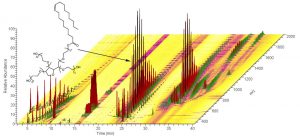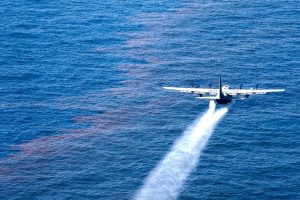Deconstructing Dispersants
– November 20, 2012
In the aftermath of the Deepwater Horizon oil spill (DHOS), the National Commission on the BP Deepwater Horizon Oil Spill and Offshore Drilling estimates that responders sprayed over 1.8 million gallons of the dispersant Corexit 9500 into the northern Gulf of Mexico (GOM). Some heralded this move as an act of genius that dramatically reduced the impact of the oil on marine and coastal ecosystems. Others questioned whether the cure might be as bad as the disease, wondering what—if any—negative consequences the dispersant itself might have had.
In their GoMRI RFP-II grant, Characterizing the Composition and Biogeochemical Behavior of Dispersants and Their Transformation Products in Gulf of Mexico Coastal Ecosystems, Kevin Armbrust, Mississippi’s State Chemist, and Darrell Sparks of Mississippi State University along with Bruce Brownawell and Anne McElroy of Stony Brook University and Lee Ferguson of Duke University, have been funded to look closely at dispersants to learn more about what happens—how they degrade and what by-products might result, what their toxicity levels are, and to attempt to determine exactly how they impact the environment.
Dispersants are complex mixtures of surfactant chemicals and they work like household detergents, breaking oil up into droplets and facilitating the dissolution of the hydrophobic chemical components of oil. This allows the oil to dissolve in water, thus making it more available to be degraded by microorganisms. Armbrust explains that their ability to dissolve in water makes dispersants harder to trace through the ecosystem than historical non-polar contaminants like DDT:
Most of the historical analytical methods that were developed—and this is going back 30 or 40 years—were aimed at measuring hydrophobic materials, chemicals that don’t like water. They [dispersants] are more difficult to detect because many of the current analytical methods haven’t been designed to look for them. – Kevin Armbrust Mississippi State Chemical Lab
The team hopes to fix this difficulty in the system by systematically evaluating Corexit 9500, surfactants that are known to be active ingredients in other commercial oil dispersants registered for use in the GOM, as well as some of the new generation of dispersants being developed by a consortium based at Tulane University. One key factor that makes the investigators’ research possible is availability of new, high-resolution chemical analysis instrumentation, which for the first time makes complex dispersant component identification and characterization possible. The research group believes that better understanding of the fate of individual components of dispersants and any persistent degradation products will help in a more complete assessment of the risks associated with using different dispersant products.
Work will be done in labs using water and sediment samples from the northern GOM. Brownawell and Ferguson will explore how rapidly dispersant components degrade, how they interact or bind with the sediment, and what kinds of degradation products are produced during the process. McElroy will examine dispersant and degradation product toxicity, specifically monitoring the effects of exposure on sheepshead minnow embryos and larvae. All of the products being tested will be compared side-by-side for total environmental impact. Armbrust and Sparks at Mississippi State University will assist the groups at SUNY Stonybrook and Duke University, using the information generated by theses groups to develop methods to monitor the dispersants and their degradation products in seafood. Ultimately the State Chemist’s office plans to use the findings as a basis for future public policy decisions regarding dispersants.
Calling himself a “translator of science back to the general public,” Armbrust is in a unique post that bridges the gap between science and public policy. Armbrust, who holds a PhD in Agricultural and Environmental Chemistry, has worked for chemical giant DuPont and held a faculty position at the University of Georgia, and so is comfortable working with both the public and private sectors. The Mississippi State Chemical Lab (www.mscl.msstate.edu) that he leads is a state regulatory agency, using its staff and labs to test everything from animal feed to fertilizer to the fish caught in Mississippi waters and then make recommendations to leadership in Jackson and the public based on their findings. Academic faculty with research interests in the regulatory sciences and their students are embedded within his organization. His office works regularly with the FDA, USDA, EPA, and other government agencies to include the latest scientific discoveries regarding chemical interactions in food and environmental safety regulations.
This research is made possible by a grant from The Gulf of Mexico Research Initiative (GoMRI). The GoMRI is a 10-year, $500 million independent research program established by an agreement between BP and the Gulf of Mexico Alliance (GOMA) to study the effects of the Deepwater Horizon incident and the potential associated impact of this and similar incidents on the environment and public health.
© Copyright 2010- 2017 Gulf of Mexico Research Initiative (GoMRI) – All Rights Reserved. Redistribution is encouraged with acknowledgement to the Gulf of Mexico Research Initiative (GoMRI). Please credit images and/or videos as done in each article. Questions? Contact web-content editor Nilde “Maggie” Dannreuther, Northern Gulf Institute, Mississippi State University (maggied@ngi.msstate.edu).







